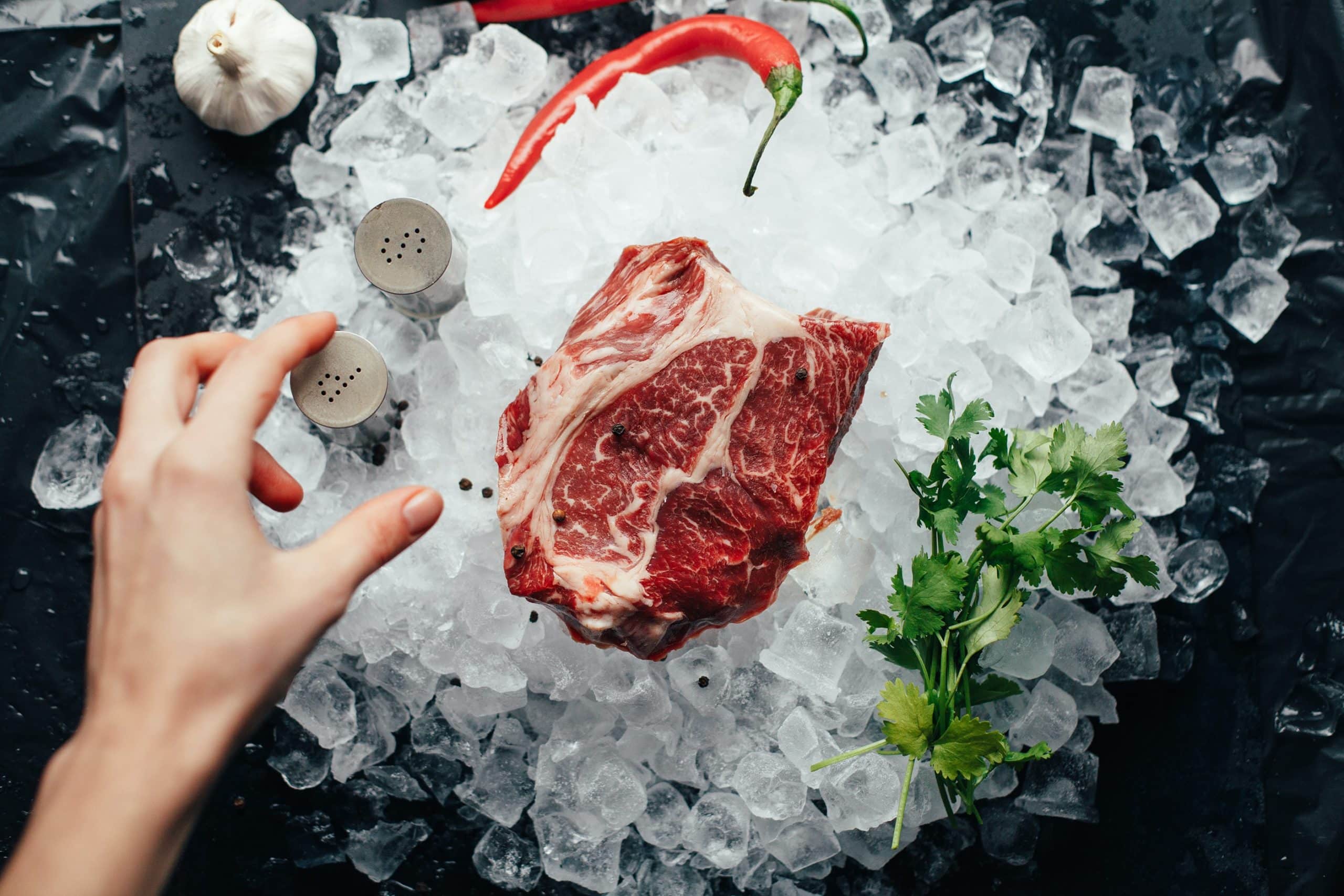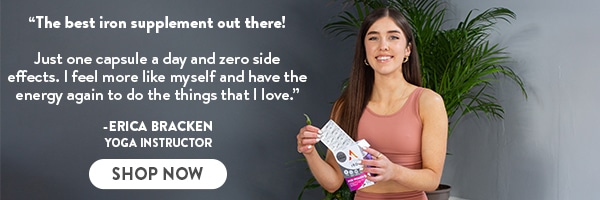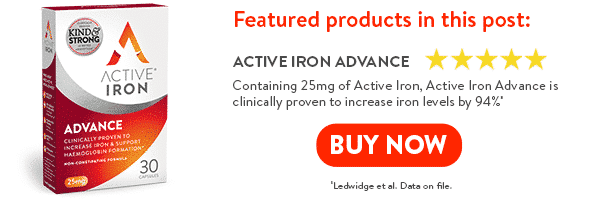Haem iron is a form of iron that’s rarely talked about. You find haem iron in animal products, such as red meat, poultry, seafood, and muscle tissue. But let’s rewind a little bit.
There are two types of iron:
- Haem iron – found in meats.
- Non-haem iron – found in plant-based foods.
Your body absorbs haem iron quicker and more effectively than non- haem iron, meaning that those on a vegetarian or plant-based diet may find they struggle to consume adequate amounts of iron on a daily basis.
In this article, we are going to discuss everything you need to know about haem iron, including:
- The different types of iron.
- The health considerations of haem iron.
- Foods that have haem iron.
- Foods that have non-haem iron.
- Supplementing with iron.
Let’s start with differentiating between the two types of Iron.
What are the Different Types of Iron?
As already mentioned, there are two types of iron – haem and non-haem iron. Meat is recognised by most as being a primary source of iron, but plenty of vegetarian-friendly foods are high in iron as well, including spinach, beans, and even chocolate!
haem iron is best found in sources of red meat, which contains blood proteins and haemoglobin. The name “haem iron” comes from the haem protein that’s attached to a lone iron atom.
The primary source of non-haem iron is plant-based food. The majority of the iron we consume is non-haem iron. Foods like rice, oats, wheat, nuts, fruits, beans all have high amounts of non-haem iron.
Your body absorbs haem iron at a higher rate compared to non-haem iron, meaning that those on a plant-based diet may not get enough iron through their diet alone. If you are a vegetarian or a vegan, you should keep in mind that your body only absorbs 2-20% of non-haem iron, whereas haem iron from animal-based sources has a 15-35% absorption rate.
Becaues of this, vegetarians and vegans have to consume twice as much iron in their diet as meat-eaters, to absorb the same amount of iron.Fortunately, there are lots of great sources for non-haem iron.
Foods like beans and leafy greens are one of the best vegetarian/vegan sources of iron. Whole-grain foods like cereals have plenty of iron in them, which makes them another attractive option for vegetarians.
Certain foods can reduce non-haem iron absorption. Dairy products, eggs, fibre, as well as tea and coffee, can all interfere with the way you absorb non-haem iron.
The good news is that you can improve your absorption of non-haem iron from food by taking vitamin C.
The most common form of supplementary iron is non-haem iron, if you are unsure when to take iron, you can check out our post on the best time to take iron.
Which Foods Have Haem Iron?
All haem iron comes from animal-based sources. Red meat and organ meats, in particular, have high amounts of haem iron. Also, foods like clams, oysters, mussels, venison and lamb chops all have a healthy amount of haem iron (between 2-23 mg). Red meat is not only an excellent source of haem iron, but it is also a source of high-quality protein as well.
If you want to increase your intake of iron, and specifically haem iron, you should aim to include more animal-based foods in your diet.
Sources of Haem Iron
As we have seen, the main source of haem iron is meat. This is because meat has many blood proteins and haemoglobin, which help the body transport oxygen.
If you want to increase the amount of haem iron in your diet, here are the best foods to include.
- Organ meats: Kidneys, liver, brain and heart are incredibly nutritious and score highly for haem iron. The liver, in particular, is one of the most nutrient-dense organ meats and contains plenty of haem iron.
- Red meat: Often given bad press, red meat is, however, packed full of protein and essential vitamins and minerals, including iron. When it comes to haem iron, all red meats pack a punch. Including lots of steaks, chops and mince in your diet will increase your haem iron intake.
- Poultry: Although not as iron-rich as red meat, chicken and turkey are nevertheless good sources of haem iron.
- Fish and shellfish: Other excellent choices rich in haem iron include fish and shellfish. Canned varieties of fish, especially sardines and tuna, are excellent choices. And clams, oysters and mussels will also deliver a healthy dose of haem iron.
Most people get enough haem iron from their diet. However, others find it difficult to get sufficient iron from food alone. These people may choose to increase their intake of iron supplements.
Which Foods Contain Non-Haem Iron?
For vegetarians and vegans, there are plenty of good options to get enough iron from plant-based sources.
Here are some of the best sources of non-haem iron:
- Legumes
Foods like tofu, tempeh and soybeans are packed with high-quality iron. They are rich in fibre as well as protein, so they can definitely support your healthy lifestyle. Other great sources of non-haem iron are lentils and beans.
- Nuts
Nuts and seeds are not only packed with iron but with high-quality protein and fats as well. They can help you increase your iron and omega-3 fatty acids intake.
- Veggies
Vegetables including leafy greens, potatoes, tomatoes and mushrooms are all non-haem iron-rich foods. Leafy green vegetables such as spinach contain oxalates which can make the iron in these foods difficult to absorb. Eating non haem iron rich foods with haem iron rich foods such as meat can also help increase absorption.
- Fruits
Most people aren’t aware that fruits have high amounts of iron. Foods like prunes, olives and mulberries are all great sources of iron. They are also rich in fibre and other vitamins which means that adding them to your diet will help your healthy lifestyle.
- Whole Grains
Whole grains are incredibly beneficial as long as they aren’t processed. When they are processed, they lose fibre, antioxidants and minerals like iron. That’s why whole grains typically have more iron than processed grains.
- Coconut Milk
Coconut milk is high in fat and it’s also an excellent source of vitamins and minerals like magnesium, copper, manganese and iron.
- Dark Chocolate
One of the most delicious foods containing non-haem iron is dark chocolate. It’s full of nutrients like magnesium, copper and iron. Also, dark chocolate has a lot of fibre which will keep you full.
What are the Health Risks of Haem Iron?
While iron is an essential mineral for your body, massively increasing your absorption of haem iron can cause a few problems. Too much iron can lead to problems like inflammation and even DNA damage because of the production of a dangerous free radical that’s called hydroxyl.
It’s all about striking the right balance. If you don’t have enough iron in your system, you’re risking not giving your body the resources it needs to function properly.
Your body can naturally regulate the iron you absorb from plant-based foods which prevents iron overload. Haem iron from animal-based foods is more easily absorbed, but your body does not regulate it very well.
Conclusion
To summarize, you can find haem iron in animal-based foods like red meat, chicken and fish.
Plant-based foods, on the other hand, contain non-haem iron (which is harder to absorb).
Your body has systems in place to regulate your non-haem iron intake, but it doesn’t regulate the intake of haem iron as easily, so it is all about getting the right balance between eating animal and plant-based foods.
Excellent sources of non-haem iron are foods include nuts, whole grains, leafy greens and dark chocolate.
Another great way to ensure you get a healthy amount of iron is by taking iron supplements, however many people complain of side effects from poorly-absorbed iron supplements. One way to combat this problem is taking vitamin C along with your iron supplement.
However, Active Iron doesn’t have this issue. Active Iron works synergistically with your body to ensure you get the right amount of iron while being gentle on your stomach.
If you want to learn more about iron, feel free to explore the following articles:
How to Take Iron Supplements for Best Absorption
Iron for Vegetarians: Plant Based Iron Sources to Maintain Iron Intake
When is the Best Time to Take Iron?
*Wang et al. 2017, Acta Haematological, 138: 223-232



